

Container Sideboard by Alain Gilles for Casamania. Brussels designer Alain Gilles has designed this modular storage system for Italian brand Casamania.
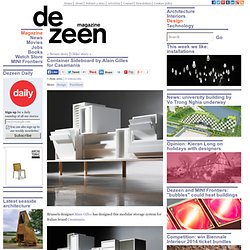
Called Container Sideboard, the design consists of a wooden plinth underneath variously sized boxes, drawer units, fold-out cabinets and filing trays. These elements can be reconfigured as required. More about Alain Gilles on Dezeen » More about Casamania on Dezeen » The information below is from Alain Gilles: Poles Apart by Adrian Bergman. New Designers 2011: London Metropolitan University graduate Adrian Bergman has designed a modular retail display system that's only held together by rubber rings.
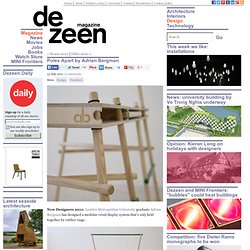
Shopkeepers can use the Poles Apart kit to assemble or reconfigure display tables and rails without tools, nails, glue or screws. Rubber rings on both sides of angled holes in the table top hold the legs in place. The New Designers show took place in London from 6 to 9 July. See more work from the show here. The following information is provided by the designer: Objects by Estudio Carme Pinós. Estudio Carme Pinós have designed their first furniture collection, including various styles of modular shelving and a wardrobe that hangs freely from the wall.
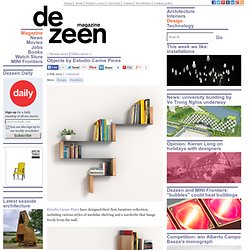
The Barcelona-based studio have created 11 pieces for the Objects collection, including a shelf with a hanging rail fixed underneath for clothes storage. There are also angular shelves inspired by the metal supports for trestle tables and U-shaped shelves which complement the black and white side tables. A wardrobe affixed to the wall floats free from the ground, with shelves and a hanging rail concealed behind the door. New technology such as 3D cutting allowed the studio to localise production and the collection has been manufactured entirely in Spain. Carme Pinós has won a number of architectural awards, including the National Prize for Architecture for the Escuela Hogar in Morella in 2005. M.A.S.S.A.S. sofas by Patricia Urquiola for Moroso. Lana Mangas rugs and seating by Patricia Urquiola for Gan. Maison&Objet 2013: these ice-cream coloured poufs and rugs by Spanish designer Patricia Urquiola for Spanish textile brand Gan were launched at Maison&Objet design fair in Paris this week.
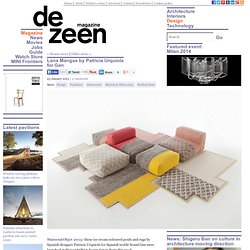
Patricia Urquiola's Lana Mangas collection for Gan, a division of the Gandia Blasco design brand, comprises modular components that can be arranged in a variety of configurations. The range includes cross-shaped rugs that form an interlocking floor covering. A seating module with a small backrest can be combined with square and rectangular poufs to form flexible seating arrangements. The designer selected a palette of yellow, coral, pink, grey and ivory for the collection. X-System by Alexander Lotersztain. Brisbane designer Alexander Lotersztain has created X-System, a shelving system for Australian brand Planex.

The modular system features X-shaped pillars that slot into rails on the shelves, and only requires an Allen key for assembly. The following is from Planex: X = the universal answer to shelving X-System, the latest release from Australian design-manufacturer Planex in collaboration with Brisbane-based designer Alexander Lotersztain, is a unique, modular shelving system that combines strength, simplicity, minimalism and versatility.
Build by Jack Godfrey Wood and Tom Ballhatchet for Movisi. Product news: this modular shelving is built from tessellating coffin-shaped blocks that can also be used as stools or tables.
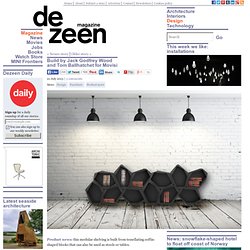
Designed by British designers Jack Godfrey Wood and Tom Ballhatchet for furniture brand Movisi, the Build shelving is made from a series of identical units that tesselate in various orientations. The lightweight system is made from expanded polypropylene, which Movisi claim is completely non-toxic. "Build is stylish, functional, 100% recyclable and actually safe enough to eat," says brand founder Natascha Stojanovic. Triangular clips slot into the backs of each module to hold them together, making it easy to create various freestanding assemblies. When dismantled, the shelving can be used as temporary seating, individual transport boxes, or as small tables. The Build shelves come in either smooth black or textured white finishes. Public Office Landscape by Fuseproject for Herman Miller. Product news: Yves Behar's San Francisco studio Fuseproject launches an office furniture system for American design brand Herman Miller at the Neocon trade fair in Chicago this week (+ slideshow).
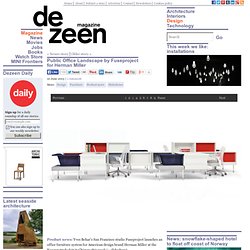
Called Public Office Landscape, the modular design by Fuseproject for Herman Miller aims to encourage spontaneous conversations and continuous collaboration between employees. Rather than design desks for individuals interspersed with pockets of collaborative meeting areas, Behar wanted to spread collaboration evenly throughout the office. The designers came up with three main concepts: social desks for individuals to work in configurations that encourage interaction, group spaces for focussed collaboration and spaces in between that facilitate casual interactions and community. The resulting modular system features seating elements that flow into desks and soft fabrics that flow into hard surfaces.
Neocon continues until 12 June. The statement below is from Yves Behar: Prisma chairs by Alexander Lotersztain for Derlot Editions. Product news: these angular lounge chairs and ottomans by Brisbane designer Alexander Lotersztain can be tessellated in an endless array of shapes and patterns.
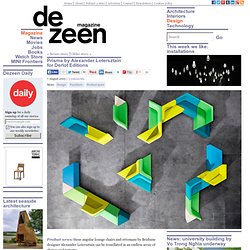
Created for Lotersztain's contemporary furniture and lighting brand Derlot Editions, each Prisma seat has an angular asymmetric form so they can be clustered together. Stacked together they can form long sofas, small armchairs or banks of seating. Their shapes allow them to be positioned in the centre of the room, against the walls or in corners. Docks furniture system for Ophelis by Till Grosch and Bjorn Meier. Product news: German designers Till Grosch and Björn Meier have created a modular office furniture system that can be arranged in a variety of groups and islands (+ slideshow).
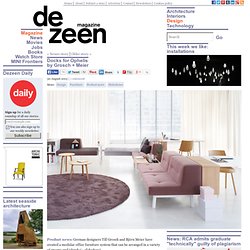
Interior designers Ophelis asked Till Grosch and Björn Meier to develop pieces of furniture to occupy areas between workstations in an office. The Docks collection includes chairs, tables, shelves and cabinets that can fit together to form open-plan meeting spaces, small pods for individual work and areas for rest and relaxation. The pieces are made from aluminium with an oak veneer and high-pressure laminate, while seating is upholstered in a range of pastel-coloured fabrics. The Berlin-based designers said with an unlimited amount of possible combinations, they focused on designing the individual parts so that each configuration is perceived as self contained furniture. Patricia Urquiola upholsters modular sofa for Moroso in jersey fabric. SimpliSeat on Behance. MOB. Mobiliario interior. on Behance. Stackle shelving system designed by THINKK Studio. Bangkok designers THINKK Studio have created a modular shelving system made from wooden batons with perforated aluminium surfaces that slot in to create dividers or hide clutter.
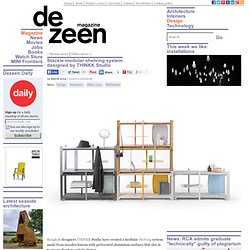
THINKK Studio wanted to develop a versatile, stackable shelving design that provides multiple functionalities, including hanging space and adjustable surfaces. "To find a fresh system for modular shelving we decided to start the project by thinking about detail first," the designers told Dezeen. They created a framework comprising jointed wooden batons that stack neatly thanks to the arrangement at each corner and don't require any additional fixings to lock the individual modules together. "The cross-section of the four legs is intentionally designed for stacking," added the designers. "When the shelves are flipped horizontally and stacked on top of another one, the legs perfectly insert down and sit on the lower shelf. " Entailles by Philippe Nigro for Ligne Roset. Cologne 2011: designer Philippe Nigro presented this set of bright yellow divans, two tables and a foot stool for Ligne Roset at imm cologne last month.
Called Entailles, the sofas can be arranged in different configurations to make a one, two or three-seater platform. Tables slot into gaps between the seats. Big-Game to present metal coat rack for HAY in Milan. Milan 2014: Swiss studio Big-Game will present a combined coat rack and picture ledge for Danish brand Hay during Milan's design week (+ slideshow). The BEAM coat rack by Big-Game allows the user to slide as many coat hooks onto the profile as needed and display thin items at the same time. "We found it useful to be able to slide the hooks on the metal beam wherever you need them," the designers told Dezeen.
Stacking Throne by Laurens van Wieringen. Milan 2011: Amsterdam designer Laurens van Wieringen presents this piled-up child's chair at Ventura Lambrate this week. Called stacking throne, the seat can be lowered as the child grows by removing up to four of the foam components, which can then be used as toys or reconfigured into shelving. The exhibition continues until 17 April. Phonebloks mobile phone concept by Dave Hakkens. Dutch Design Week 2013: Design Academy Eindhoven graduate Dave Hakkens' concept for a mobile phone made of detachable blocks has gone viral, attracting over 16 million views on YouTube and garnering almost a million supporters online (+ movie + interview). "I put the video online and in the first 24 hours I had like one million views on YouTube," Hakkens told Dezeen. "I got a lot of responses to it. " Dutch designer Hakkens, who graduated from Design Academy Eindhoven this summer, presented his Phonebloks concept at the academy's graduation show in Eindhoven today at the start of Dutch Design Week.
Phonebloks is a concept for a phone made of swappable components that fit together like Lego, with each component containing a different function. This means that components can be replaced or upgraded without having to throw away the phone. "Usually a phone is integrated into one solid block and if one part gets broken you have to throw away the entire phone," said Hakkens. Ying Chang takes graphic design’s grid system into three dimensions. Room shelving system functions like a huge shape-sorter toy. Stockholm designers Erik Olovsson and Kyuhyung Cho added different shaped holes to the stackable wooden blocks that make up this flexible shelving unit, creating spaces suited to displaying various items. With the Room system, Olovsson and Cho wanted to challenge the assumption that objects should always be displayed within a rectangular space.
They created a modular system of 25 stackable blocks, a low table and a stainless mirror piece. Each part features a geometric void, the shape of which is defined by the objects it might hold, from books to vases, bottles and plants. "We put things into square spaces without thinking about the relationship between the object and the room it's in," Olovsson told Dezeen. Torafu Architects designs multi-functional Dice furniture. Itisy table by Philippine Lemaire for Ligne Roset. Brackets modular office furniture by Nendo for Kokuyo. Seating Stones by UNStudio. 3+ furniture collection by Oskar Zieta.